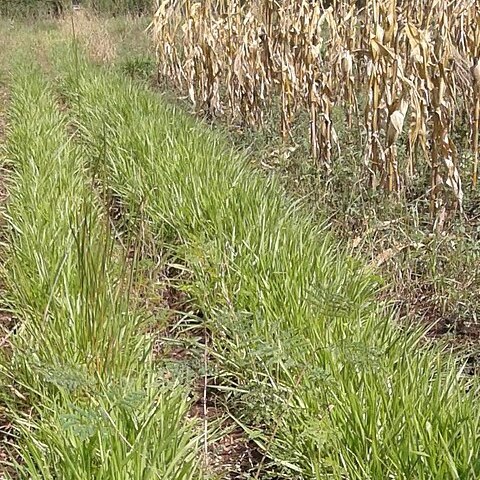Loosely tufted, often robust perennial 300-2000 mm high. Leaf blade 100-400 x 7-20 mm; ligule a fringed membrane. Racemes 25-100 mm long, secund; rachis ±1 mm wide, crescentic in section, with narrow inrolled wings, ciliate on margins; spikelets arranged in a single row or occasionally two rowed near the base; pedicels of equal lengths. Spikelet 4-6 mm long; lower glume less than 1/2 as long as spikelet, deeply concave with edges upturned, separated from upper glume by a short internode, 7-nerved; lower lemma resembles upper glume; upper lemma acute, granulose; anther 2.8-3.3 mm long.
Perennial, loosely tufted (often robust), up to 2 m high. Leaf blades 100-400 mm long, 7-20 mm wide. Spikelets 4-6 mm long. Racemes secund, 25-100 mm long; spikelets arranged in a single row or occasionally with 2 rows near base, pedicels equal; lower glume 7-nerved, less than half the spikelet length, separated from upper glume by a short internode.
A grass. It is stout and rigid and grows 1.3 m high. It forms tussocks. The leaves are long and tapering. They have thick rough edges. There are up to 15 flower heads per stalk. The seed heads have seeds on one side. These heads are 8 cm long. The spikelets are 4-6 mm long.
Inflorescence of (1)2–16 racemes, these mostly 4–20 cm. long, bearing spikelets singly and usually in 1 row; rhachis crescentic in section, c. 1 mm. wide with narrow involute wings, ciliate on the margins.
Inferior glume 1/3 length of spikelet, acute or obtuse, separated from the superior by a short internode; superior glume cartilaginous, dully shining.
Spikelets 4–6 mm. long, glabrous or sometimes sparsely pubescent, obtuse to subacute with a slight stipe at base.
Inferior lemma cartilaginous, dully shining. Superior lemma granulose, subacute.
Culms 30–200 cm. high, erect or sometimes geniculately ascending.
Robust perennial up to about 2 m. high.
Leaf laminae 3–20 mm. wide, flat.
Tufted perennial.

